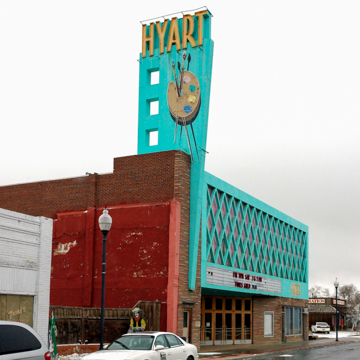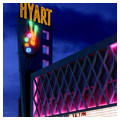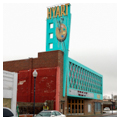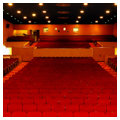The Hyart Theatre is located in the heart of downtown Lovell and is the center of activity in the rural Big Horn Basin. As in many parts of rural America, choices for entertainment are limited, and the importance of the Hyart as a de facto community center is evident in its popularity in the decades after its construction and, more recently, following its heralded 2004 revitalization.
Hyrum “Hy” Bischoff built the Hyart Theatre in 1950. His father, Dan Bischoff, had owned theaters in Lovell and in nearby Cowley, and operated a traveling movie projection business throughout the Big Horn Basin using a portable generator. When Dan died in 1931, Hy took over his theaters. By 1949, the Bischoff family began touring theaters in Wyoming, Montana, Colorado, and Utah to gather ideas for a new state-of-the-art theater to be built in Lovell. Salt Lake City’s Villa Theatre, newly constructed in 1949, was Hy’s favorite and became the model for the Hyart lobby.
Despite the growing popularity of television in the 1950s, Hy remained optimistic about the future of movie theaters. Lovell’s population at the time was less than 2,000, yet the Hyart auditorium contained 1,001 seats at the time of its completion. In June 1951, the Hyart opened with a screening of Fred Astaire and Jane Powell’s Royal Wedding. The $250,000 building became the showpiece of Lovell’s downtown and drew patrons from all over the Big Horn Basin.
At the time of its construction, traditional building materials were in short supply due to the Korean War. Because of this shortage, the Hyart Theatre was built of structural tile faced with brick and rhyolite, a volcanic stone cut from a quarry in Idaho Falls, Idaho. Structural trusses were salvaged from steel rails used at old mines in nearby Bearcreek, Montana. The lower portion of the theater’s facade is faced with irregularly sized, long, narrow courses of rhyolite. A concrete plaque reading “THEATRE BLDG. H. D. Bischoff 1950” is embedded in the rhyolite just west of the inset angled entrance. The upper portion of the facade forms the canopy over the entrance. The most prominent feature of the Hyart is the quadrilateral sheet-metal pylon that towers above and perpendicular to the facade, and supports a neon-lit palette and the theater’s name. Most of the upper story consists of pink sheet-metal panels covered with turquoise-colored, sheet-metal lattice. These colors are especially striking in contrast to the more traditional hues of Lovell’s other downtown buildings.
The lobby of the Hyart Theater includes a sunken lounge with a mirrored back wall and cedar paneling from the Big Horn Mountains. All features of the lobby, including the furniture and even the carpeting, are original to the theater. The auditorium seating is designed with comfort in mind: the Hyart features three seat sizes and 40 inches of space between rows of seats (as compared with the standard 34-to-36-inch separation). Like many theaters of its era, the Hyart includes a soundproof cry room for its youngest patrons.
Business declined at the Hyart in the 1980s. Following Hy’s death in 1988, his daughter Loretta was able to keep the theater open for another four years. When it closed in 1992, Lovell and the surrounding communities felt its loss. In 2004, a group of Lovell residents formed the Hyart Redevelopment Committee and raised over $50,000 and received valuable in-kind contributions to update the projection equipment and sound system. Loretta Bischoff paid to repair the neon sign and sold the theater to the redevelopment committee for ten dollars. Today, the Hyart Theatre is operated mainly through volunteer efforts and is a preservation success story for Lovell and the Big Horn Basin.
References
Weidel, Nancy, “Hyart Theatre,” Big Horn County, Wyoming. National Register of Historic Places Registration Form, 2008. National Park Service, U.S. Department of the Interior, Washington, D.C.

















